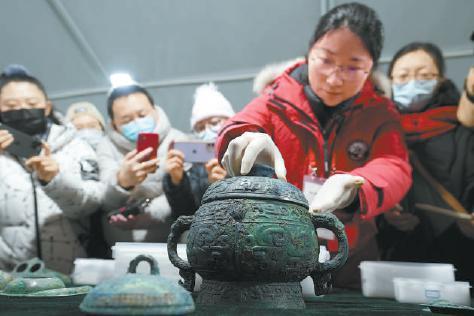Two pieces of Western Zhou Bronze Gui are successfully matched after three thousand years
According to the archaeologists, the cover and body of this copper guinea were unearthed after more than 40 years. The decorations are the same, and the inscriptions echo. It should be confused during the burial. One mistake is 3000 years.
Photo by our reporter Wu Yibin
Our reporter Li Qiyao
From the largest bronze panting unearthed in the Beijing area to the Bao Boju Li in the town hall of the Shoubo Museum, in 1974, the discovery of two large tombs brought the Liulihe site into public view, and Beijing as the veil of the capital of Yan State was also arched Workers uncovered.
After more than 40 years, new discoveries have been made in these two tombs.
The Municipal Bureau of Cultural Relics yesterday announced the important archaeological achievements of the Liulihe site: using the latest cultural relics protection technology and scientific methods, archaeologists have meticulously excavated and restored the coffins of Western Zhou tombs, which is of great significance to the study of the system of tombs and burial vessels.
One piece of copper gui was found, which is the same as the gui design unearthed more than 40 years ago, adding conclusive evidence for the study of the name and character system of the Western Zhou Dynasty.
Yesterday, the reporter saw a huge circular "deep pit" at the archaeological site of the Liulihe site. This is the tomb No. M1901 excavated this time and the tomb No. 253 excavated by the older generation of archaeologists in the 1970s.
"More than 40 years ago, the largest bronze pantograph in Beijing was unearthed here." Wang Jing, head of the archaeological excavation site at the Liulihe Site of the Municipal Cultural Relics Research Institute, introduced that the two tombs were not fully excavated due to the high groundwater level. Some details It has not been fully revealed. This year, in order to build the Liulihe National Archaeological Site Park, archaeologists re-excavated two early Western Zhou tombs numbered M1901 and M1903.
During the excavation, the archaeologists discovered an interesting event.
The newly unearthed copper gui from tomb No. M1901 is the same as the scorpion pattern unearthed more than 40 years ago. The inscription on the cover of the vessel is "Bai (Bo) Yuzuo Baozun Yi". ".
"According to the inscription, the cover and the main body of the two pieces of guilt should have been confused during the burial. The mistake was 3000 years." Wang Jing said that the two reunited objects after more than 40 years proved Boyu and Qishi. For the same person, added conclusive evidence for the research on the name and character system of the Western Zhou Dynasty.
At the same time, the newly unearthed bronze masks, bronze ornaments with animal faces, and groups of bronze carriages and horses, etc., are all discovered for the first time, with exquisite patterns and rich details.
“A total of 5 early Western Zhou Dynasty tombs were unearthed this time. Tomb M1902 was newly discovered, and it also brought us many surprises.” Wang Jing revealed that the tomb found the earliest tomb head box cover of the age known in Beijing. It is also rare in northern regions.
Inside the box are copper lifting beams, bronze statues, bronze jues, bronze tripods, bronze swords, lacquerware, pottery, etc., with rich combinations.
The coffin and human bones are well preserved. The entire dog was found on the coffin board, and a copper bell was unearthed together with the dog.
In order to fill in the gaps in the field excavations and further study the coffin rules of Western Zhou tombs, archaeologists for the first time adopted the "broken wall excavation method" of cleaning from outside the coffin chamber inward to clean up key phenomena and unearthed artifacts, and leave the key traces in sections. .
For the first time, the wooden arrow shafts and mat patterns of the bronze arrows in the Western Zhou Dynasty in Beijing were identified, and the silk fabrics with patterns in the early Western Zhou Dynasty in Beijing were successfully extracted for the first time, and the spatial location of each unearthed artifact was accurately restored, providing a wealth for restoring the funeral system at that time. Material.
Through scientific and technological means, archaeologists have a new understanding of the scope of the Liulihe site.
The Liulihe Site established a WebGIS geographic information system in a large site in Beijing for the first time, integrating the results of remote sensing archaeology, coordinate information, aerial photography, electrical geophysical prospecting, exploration and excavation into a single map of the large site, layer by layer. Drawing, photographing, building three-dimensional models, and comprehensively collecting information.
Archaeologists completed key exploration areas of approximately 320,000 square meters and sampled exploration areas of 450,000 square meters. The protected area of the site is 17.3 square kilometers, far exceeding the previous knowledge of the site.

